Vista Land Stocks Review: The Underlying Value Of VLL
After so much work for the past weeks, I finally now have the chance to do some stock valuations. Now that the PSEi is nearing the 7,800 mark, I wonder if there are still stocks out there that are still undervalued.
I chanced upon Vista Land & Lifescapes’ stock. I checked the P/E Ratio and found out that VLL is currently trading at 8 times earnings so I did take a look at the fundamentals to see if this is a good buy now so here’s my Vista Land stock review.
How Does Vista Land & Lifescapes Inc. Make Money?
VLL is one of the leading property developer and home builder in the Philippines. They operate their business and make money through six distinct business units as enumerated below.
- Starmalls Inc. – A major developer, owner and operator of retail malls and BPO commercial centers in the country. VLL owns 88.34% of Starmalls. There are currently 9 malls operating and are located at Las Piñas, Edsa-Shaw, Alabang, San Jose Del Monte, Taguig, Talisay, Daang Hari, Sta. Rosa and Bataan.
- Camella Homes – Camella homes has been servicing on the low-cost housing market (Php 4M and below) for 40 years and markets its houses on the “Camella” brand.
- Crown Asia – Crown Asia caters on the mid-cost housing segment (Php 4M – 12M).
- Brittany – Brittany caters on the luxury housing market (Php 12M and above).
- Vista Residences – Vista Residences caters on the vertical hi-rise residential housing market in the low to upper mid-cost segments.
- Communities Philippines – Offers residential properties outside Manila that are under the “Camella” and “Crown Asia” brands.
The Company’s Competition
The residential market is really a competitive business. Its competition in the housing market are Filinvest Land, Extraordinary Development Corp., Sta Lucia Realty & Dev’t Inc., Megaworld Corp., Robinsons Land Corp., 8990 Holdings Inc., and others.
In the hi-rise condominium housing segment, they are in competition with Ayala Land Inc., DMCI Homes, Megaworld Corp., Robinsons Land Corp., SM Residences and others.
Their retail mall business competes directly with Robinsons, SM and Ayala Land.
VLL’s market share for real estate sales based on the 9 months ended September 30, 2015 is only 14% while in the rental income, VLL only contributed 3% of the market share. This tells me that VLL is having a hard time competing in other real estate giants.
Does VLL Has Some Form Of Competitive Advantage?
I’ll try to analyze and see if VLL has some form of competitive advantage.
- Brand Name – Does Camella Homes and Crown Asia ring a bell? If I hear these words, the first thing that comes from my mind is a nice big house.
- Product or Service – They sell houses; small, medium and big houses. They also do rental business.
- Debts – VLL carries Php 64.6B in debts versus an earnings of around Php 7B. If they maintain their earnings, they can pay off the debt within 9 and 1/4 years. I think this is too long and not good. I prefer a company that has strong earnings so strong that it can pay of its debts in just 2 to 4 years.
- Earnings – The earnings per share is in a rising trend as shown in the chart below. Doing the math in a 7-year timeline from 2009 to 2015 shows a compounded annual growth rate of 8.48% using the median method.
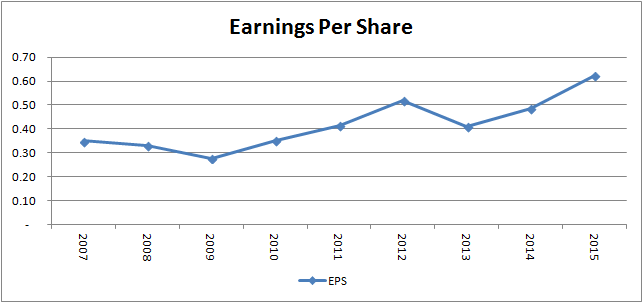
Fig. 1 Earnings Per Share
- Capital Allocation – Business operations are within their expertise; that is real estate. They are investing their capital to grow their real estate portfolio.
- Share Buybacks – Shares outstanding has increased from 8.5M at the end of 2007 to 12.5M at the end of 2015. Take note that last March 17, 2015, the Board of Directors announced share buyback over the next 24 months. Budget allocated is 1.5B Pesos.
- Shareholder Value – Between the end of 2007 and the end of 2015, total earnings are Php 3.76 per share. Dividends paid out in that same period totalled to Php 0.66 per share. Subtracting the two, we get Php 3.10 per share in retained earnings. In 2007, the earnings per share is Php 0.35 and in 2015, it is Php 0.62. Subtracting the two, we get Php 0.27. The data tells me that the Php 3.10 per share retained produced an additional income of Php 0.27 per share for a return of 8.71% (0.27/3.10). This tells me that the company did a mediocre job in reinvesting their retained earnings of Php 3.10 per share within the 9-year period.
- Return on Equity – Average RoE is 9.01%. I usually prefer 10% or higher so this falls short in my metrics. RoE is not erratic which suggests that they might have a competitive advantage.

Fig. 2 Return On Equity
- Return on Total Capital – Average RoTC is 9.38%. It would be nice if this will also reach at least 10% but still, it’s a good sign. It’s also not erratic and is a sign of a competitive advantage.
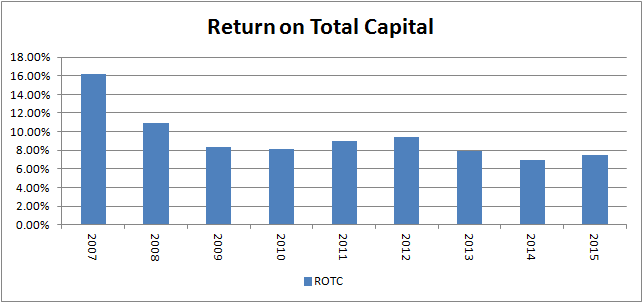
Fig. 3 Return On Total Capital
- Inflation – Home prices rise at a similar rate as the rate of inflation. So I think VLL adjusts its prices right along with inflation.
- Capital Expenditures – VLL’s Research & Dev’t activities focuses on construction methodology, value engineering, quality assurance and market studies. The expenses incurred on this activities are not material. Total capital expenditure for 2015 amounted to Php 31,499.9M and a budget of Php 36,061.20M was allocated for 2016.
To summarize the above analysis, I can say that despite the large debt, low RoE and RoTC, VLL is a very stable and predictable company to invest with. With that, I’ll now look what the financial statements have to say.
The Valuations
I look at the Revenue, Net Income, Cash & Short-Term Investments, Total Inventory and Retained Earnings from the period of 2007 up to 2015 to see if there’s an upward trend.

Fig. 4 Revenue, Net Income, Cash & Short-Term Investments, Total Inventory and Retained Earnings
I see that Revenue, Net Income and Retained Earnings are in an upward trend. Revenue has grown at a compounded annual growth rate of 12.80%, Net Income by 8.19% and Retained Earnings by 27.31%.
The Cash & Short-Term Investments and Total Inventory shows a sideways trend but that’s okay as long as it doesn’t show a downward trend. The charts tell me that this company has strong fundamentals.
The Book Value Per Share also shows an upward trend which tells me that the shareholder’s equity is increasing every year which I definitely want in a company. It tells me that the company is doing a good job every year in increasing its equity.
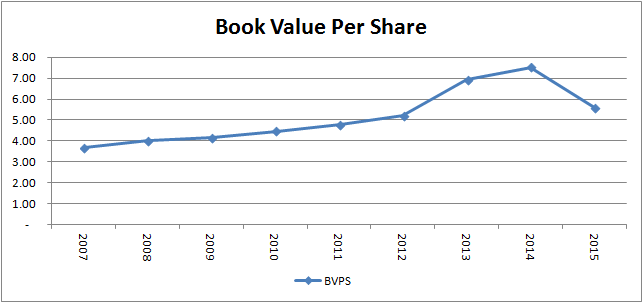
Fig. 5 Book Value Per Share
But there’s also this upward trend on their debts.
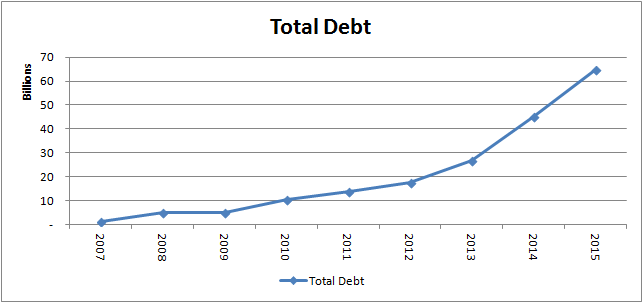
Fig. 6 Total Debt
I found out that the bulk of this debt came from bank loans which are used for capital expenditures and for general corporate purposes; and the issuance of dollar denominated notes used to settle outstanding notes payable.
To me, as long as debt is used to finance operations to expand the business, it’s okay.
Financial Ratios
The P/E, P/BV, Current Ratio and Debt to Equity Ratio at the end of 2015 is as follows;
- P/E is 8.33. This tells me that for every Php 8.33 I spend to buy this stock, I expect to earn Php 1.00 1 year later. It also means that if I invest a certain amount of money, I’ll expect a 12% return within a year.
- P/BV is 0.93. This tells me that for every Php 0.93 I spend to buy this stock, I would have Php 1.00 of equity in the business. This is good because you pay low but you get more. In another perspective, if you spent Php 930,000.00 to buy this stock and the company decided to liquidate tomorrow and sold all of its assets, you would get Php 1,000,000.00.
- Current Ratio is 3.42. This tells me that the current assets exceed the current liabilities. Money flowing in is greater than the money flowing out. The extra money that remains can be used to build more equity. I want companies that have a current ratio of 1.5 so this is actually a very good indicator.
- Debt to Equity Ratio is 1.19. This tells me that for every Php 1.00 of equity, there’s Php 1.19 of debt. I’m looking for a debt to equity ratio of 0.5 or below. This also tells me the management’s effectiveness in using debt to grow equity in the business. The management should strengthen their cash flow to cover up the debts they make.
I also took the average of the following metrics below for the 9-year period.
- Gross Profit Margin is 55.65%. Great!
- Selling, General & Admin to Gross Profit is 35.51%. It would be better if this is below 30%. But with just exceeding by about 5.51%, I think it’s good.
- Research & Development to Operating Profit is 0%. I love it when you don’t have to spend on research & development.
- Depreciation to Gross Profit is 2.31%. Great!
- Interest Expense to Operating Profit is 18.11%. It would be better if this is below 15% but it’s already near the benchmark so I guess it’s fine.
- Net Income to Revenue is 25.13%. Great!
All of these metrics tell me that the company is undervalued and have a competitive advantage. This is a good company to invest in the long-term.
Identifying At What Price To Buy
At the end of 2015, VLL reported an earnings of 0.622 per share. The 10-yr Gov’t Bond yield today is 4.435%. The computation is as follows;
[alert-note]Relative value = 0.622/0.04435 = Php 14.02[/alert-note]
If I buy the stock at Php 14.02 per share, I would get a 4.435% return same just like a government bond. Today, the stock price closed at Php 5.33 per share. If I buy at this price, it would give me a return of 11.67% which is much higher because I paid for the stock less than the relative value if the stock were treated just like a bond.
[alert-note]Rate of Return = 0.622/5.33 = 11.67%[/alert-note]
The earnings per share is growing at 8.28% annual growth rate. This tells us that if I buy VLL today at Php 5.33, I would get an investment that pays an initial rate of return of 11.67% with a coupon that is projected to increase annually at 8.28%.
The price you pay today will determine how much your money will grow if you hold it for the long-term. With these computations, I can say that it’s a good buy at what the market is currently offering. If you can buy lower than Php 5.33, it’s much better.
Projecting The Future Price After 10 Years
Let’s say I just bought the company for an average of Php 5.33 per share. Great! Now I want to know what would be the projected price of the stock if I decide to hold on to this for 10 years.
To do this, I first computed the 7-year EPS growth rates for different periods and took the median of the figures.
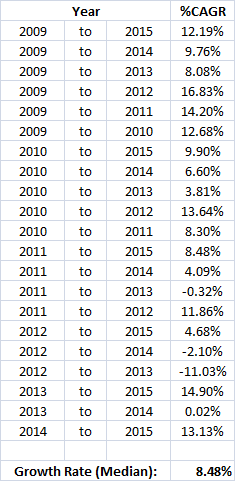
Fig. 7 Growth Rate
I also computed for the average dividend payout ratio.
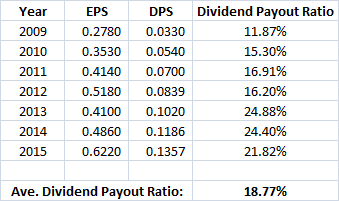
Fig. 8 Dividend Payout Ratio
Assuming that the per share earnings continue to grow at 8.48% and the company continues to pay 18.77% of that earnings into dividends, we can now project the future earnings in 10-years.
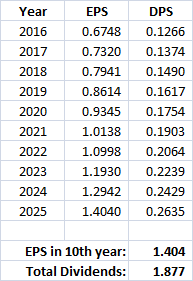
Fig. 9 Dividend Per Share
The average P/E ratio for the past 7 years is 9.84. Multiplying the 10th year earnings per share, we get;
[alert-note]Projected future price after 10 years = 9.84 x 1.404 = Php 13.82 per share[/alert-note]
The total dividends paid out would be Php 1.877 per share. Adding it in the projected future price, we get;
[alert-note]Total gain = 13.82 + 1.877 = Php 15.69 per share[/alert-note]
Your projected rate of return in 10 years would be;
[alert-note]Rate of return = [(15.69/5.33)^(1/10)] – 1 = 11.40%[/alert-note]
Final Thoughts
If I’ll buy VLL today at an average price of Php 5.33 a share, I should expect an average return of 11.40% within a 10 year time frame. If I’ll buy at a much lower price, then my average return will jump higher.
If I can buy it at a price where my return rate would be 20%, that is what I’ll do. If there will be an event like a bad news phenomenon that will drive the stock price down, I’ll be buying for sure.
This is what Warren Buffett is talking about; the price you pay today will determine how much money you’ll make in the future.
Happy investing!
